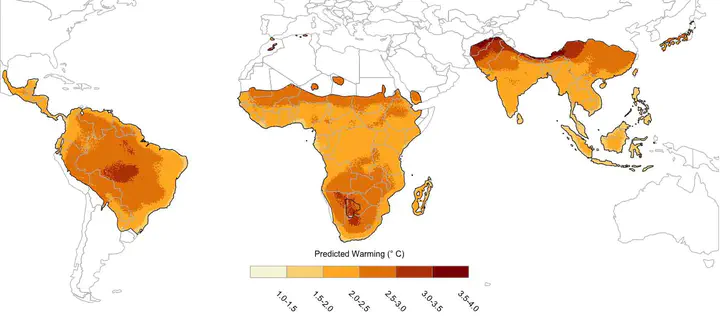Primate responses to changing environments.
 Predicted change in average annual temperature in primate habitats (1960-1990 vs. 2061-2080). Black lines indicate the distribution of extant primates and colors the change in temperature (°C) as predicted by CMIP5 models using the RCP 4.5 (downloaded from www.worldclim.org).
Predicted change in average annual temperature in primate habitats (1960-1990 vs. 2061-2080). Black lines indicate the distribution of extant primates and colors the change in temperature (°C) as predicted by CMIP5 models using the RCP 4.5 (downloaded from www.worldclim.org).
According to the IUCN, about 60% of the world’s ~500 primate species are threatened by extinction, and this is mainly the result of human activity. Environmental changes linked to human activities include climate change, landscape modifications, hunting and other interactions between human and non-human primates. On the one hand, primates seem to be especially vulnerable to these rapid changes because of their slow life-histories and long generation times. On the other hand, primates show considerable behavioral flexibility, which may help them to respond to environmental change in an adaptive way (Kalbitzer & Chapman, 2018).
The question as to how such flexibility may help animals to respond to environmental changes associated with the ‘Anthropocene’ is often discussed in behavioral ecology (e.g. here or here), and insights from respective studies will help to improve the survival of endangered species. Together with collaborators, I have shown that extreme climate events impact food availability, behavior, infant survival and reproductive activity in fruit-eating spider (Ateles spp.) and capuchin (Cebus imitator) monkeys (Campos et al., 2020; Hartwell et al., 2021). I would like to continue contributing to this discussion by investigating how environmental changes affect individual behavioral patterns and survival, and, ultimately, population dynamics in different species of primates.
My research group and I now investigate the cascading effects of climate change on food availability, behavior and survival in the leaf-eating, endangered red colobus (Piliocolobus tephrosceles) in Kibale National Park, Uganda. We combine long-term data analysis with computational simulations to investigate how climate patterns are linked to the availability of young leaves (red colobus’ primary diet), and how both climate and food availability impact their behavior, fitness, and population dynamics. As part of this project, we are developing computer simulations that explore the reliability of food preference indices in different foraging contexts. Based on our results, we will use the appropriate tools to investigate the dietary requirements of red colobus and how their essential nutrients are impacted by climate patterns.